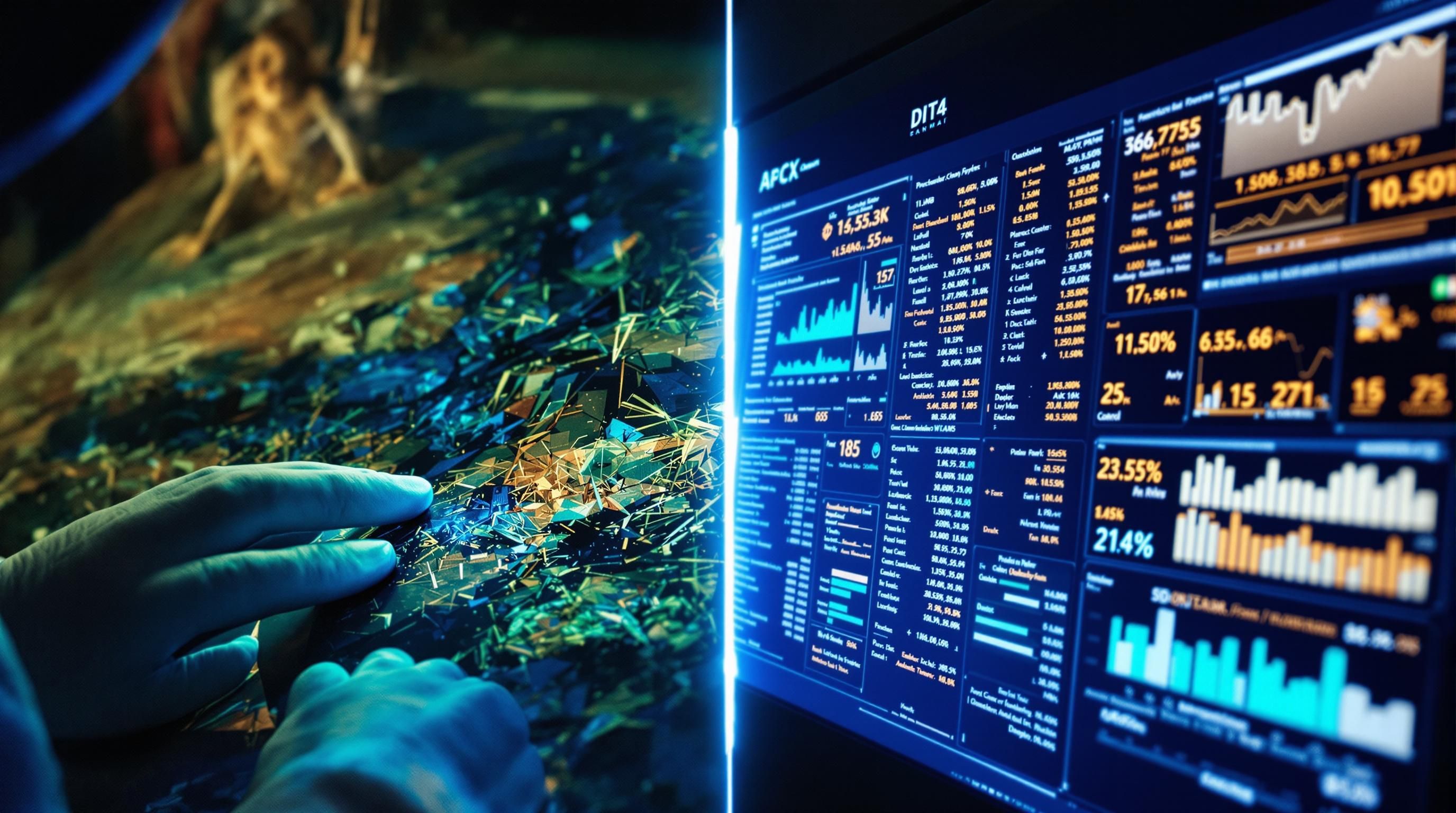Introduction to Art Valuation
Whether you’ve inherited a painting, discovered an interesting piece at a garage sale, or are considering selling artwork from your collection, understanding the value of art is essential. Art valuations serve as the foundation for insurance coverage, estate planning, tax considerations, and market transactions.
Art valuation is not simply about attaching a price tag to a piece. It’s a complex process that considers numerous factors including the artist’s reputation, the artwork’s condition, provenance, historical significance, and current market trends. In this comprehensive guide, we’ll explore the methods professionals use to determine art value and provide resources to help you navigate the appraisal process.
What Is Art Valuation?
Art valuation combines expertise in art history, current market knowledge, and analytical skills. Professional appraisers typically have backgrounds in fine arts, art history, or museum studies, along with specialized training in valuation methodologies. They follow established standards set by professional organizations such as the American Society of Appraisers, the International Society of Appraisers, or the Appraisers Association of America.
There are several different types of art valuations, each serving a specific purpose:
Types of Art Valuations
Fair Market Value: The price at which an artwork would change hands between a willing buyer and seller in an open market.
Replacement Value: The cost to replace an artwork with a comparable piece in the current retail market. Often used for insurance purposes.
Liquidation Value: The amount expected if an artwork must be sold quickly, typically lower than fair market value.
Tax-Related Value: Specific valuations for estate tax, charitable donations, or other tax purposes, adhering to IRS guidelines.
Understanding which type of valuation you need is the first step in the appraisal process.
Key Factors That Affect Art Value
Artist Reputation and Status
The artist’s reputation significantly impacts valuation. Works by established, historically significant, or critically acclaimed artists generally command higher prices. This includes:
- Recognition in the art world
- Exhibition history at major museums and galleries
- Critical reception and scholarly attention
- Position within art movements or periods
- Inclusion in important collections
Provenance and Ownership History
Provenance—the documented history of an artwork’s ownership—can dramatically affect value. Strong provenance includes:
- Documentation tracing back to the artist
- Notable previous owners
- Exhibition history
- Published references in catalogs or art literature
- Certificates of authenticity
Condition and Conservation
The physical condition of an artwork is crucial to its value. Issues that can affect valuation include:
- Damage, repairs, or restoration
- Fading, discoloration, or yellowing
- Canvas tears or paper buckling
- Frame condition (for framed works)
- Environmental damage from improper storage
Rarity and Scarcity
Rarity increases value. Limited editions, uniqueness, and scarcity in the market all contribute to higher valuations. This includes:
- Single works vs. editions
- Size of edition (for prints, photographs, sculptures)
- Early works or pieces from significant periods
- Experimental techniques or materials
Medium and Materials
The medium and materials used affect an artwork’s value:
- Traditional mediums like oil on canvas often command higher prices
- Quality and durability of materials
- Innovative or experimental techniques
- Size and scale of the work
Art Condition Assessment Factors
Key elements appraisers evaluate when assessing artwork condition
<li class="condition-checklist__item">
<input type="checkbox" disabled aria-hidden="true">
<span>Surface integrity (free of cracks, flaking)</span>
</li>
<li class="condition-checklist__item">
<input type="checkbox" disabled aria-hidden="true">
<span>Color vibrancy and fading assessment</span>
</li>
<li class="condition-checklist__item">
<input type="checkbox" disabled aria-hidden="true">
<span>Structural stability and support</span>
</li>
<li class="condition-checklist__item">
<input type="checkbox" disabled aria-hidden="true">
<span>Previous restoration or conservation work</span>
</li>
<li class="condition-checklist__item">
<input type="checkbox" disabled aria-hidden="true">
<span>Frame condition (if original)</span>
</li>
<li class="condition-checklist__item">
<input type="checkbox" disabled aria-hidden="true">
<span>Evidence of environmental damage</span>
</li>
<li class="condition-checklist__item">
<input type="checkbox" disabled aria-hidden="true">
<span>Signature clarity and authenticity</span>
</li>
Market Trends and Demand
Art values fluctuate based on market conditions:
- Current collector interest in particular artists, periods, or styles
- Recent auction results for comparable works
- Economic factors affecting the broader art market
- Gallery pricing and sales history
- Regional and international market variations
Historical and Cultural Significance
Artworks with historical importance often have increased value:
- Works that defined or changed artistic movements
- Pieces that capture significant historical moments
- Cultural relevance and enduring importance
- Scholarly recognition and academic interest
Methods of Art Valuation

Professional In-Person Appraisals
The gold standard for art valuation is an in-person evaluation by a qualified appraiser. This typically involves:
- Physical examination of the artwork
- Documentation of size, medium, condition, and signature
- Research into provenance and exhibition history
- Comparative market analysis with similar works
- Written appraisal report with detailed valuation
Professional appraisers typically charge either an hourly rate ($100-300 per hour) or a flat fee based on the artwork’s value and complexity. For valuable or important works, this investment provides the most accurate and defensible valuation.
Online Art Appraisal Services
Online appraisal services have made art valuation more accessible and affordable. These services typically require:
- Clear photographs of the artwork (front, back, signature, details)
- Measurements and information about medium/materials
- Any known provenance or history
- Payment of a fee (typically ranging from $30-250)
Popular online appraisal services include:
- MutualArt - Offers appraisals within 72 hours
- Value My Stuff - Provides valuations from experts
- Mearto - Offers quick online appraisals
While convenient, online appraisals have limitations since appraisers cannot physically examine the artwork.
Auction House Evaluations
Major auction houses like Sotheby’s, Christie’s, and Bonhams offer free valuation services for artworks they might potentially sell. This process typically involves:
- Submission of photographs and information
- Initial review by specialists
- Possible in-person examination for valuable items
- Auction estimate range provided
- Discussion of potential consignment for sale
These evaluations are free but are primarily designed for potential sellers rather than for insurance or estate purposes.
Comparative Market Analysis
This DIY approach involves researching recent sales of comparable artworks:
- Finding similar works by the same artist
- Researching recent auction results
- Examining gallery asking prices
- Analyzing online marketplace transactions
Resources for comparative research include:
- FindArtInfo - Database of auction results
- Artprice - Comprehensive price database
- Artnet Price Database - Extensive auction records
Art Appraisal Services Comparison
Cost ranges and turnaround times for different appraisal options
</tbody>
</table>
Art Valuation for Different Purposes

Insurance Appraisals
Insurance appraisals determine replacement value—what it would cost to purchase a similar work in a retail setting. Key considerations include:
- Higher valuations than fair market value
- Detailed condition reports
- Regular updates (typically every 3-5 years)
- Compliance with insurance company requirements
- Documentation of all important works in a collection
Insurance companies typically require professional appraisals for artwork valued above a certain threshold (often $5,000-$10,000).
Estate and Tax Valuations
Estate valuations for tax purposes must comply with IRS requirements:
- Must use fair market value (not replacement value)
- Requires qualified appraisers meeting IRS standards
- Needs documentation for values exceeding $5,000
- May require Form 8283 for charitable donations
- Should include thorough provenance research
The IRS Art Appraisal Services team reviews valuations for estate tax returns, charitable contributions, and other tax-related matters.
Sales and Market Valuations
When preparing to sell artwork, valuations focus on current market conditions:
- Recent sales of comparable works
- Current demand for the artist or style
- Optimal selling channels (auction, gallery, direct)
- Market timing considerations
- Realistic price expectations
Galleries, auction houses, and art advisors can provide insights into potential selling prices and strategies.
Divorce and Legal Proceedings
Art valuation for legal contexts requires:
- Impartial, court-acceptable appraisals
- Clear documentation methodology
- Potential for multiple appraisals from different experts
- Understanding of legal standards in the jurisdiction
- Consideration of potential tax implications
Courts often rely on independent appraisers agreed upon by both parties in disputes.
The Art Valuation Process
- Initial Research
Background Investigation
Gathering information about the artist, artwork, provenance, and exhibition history before physical examination. - Physical Examination
Condition Assessment
Detailed inspection of the artwork, noting medium, technique, condition issues, signature, and other physical characteristics. - Market Research
Comparative Analysis
Researching recent sales of comparable works, current market trends, and gallery pricing for similar pieces. - Value Determination
Final Valuation
Synthesizing all data to arrive at a well-supported value conclusion that reflects the purpose of the appraisal. - Report Preparation
Documentation
Creating a comprehensive written report detailing findings, methodology, and final valuation with supporting evidence.
Free and Low-Cost Art Valuation Resources
Online Auction Databases
Several online databases provide access to auction results, which can be valuable for comparative research:
- FindArtInfo offers free basic searches of auction results
- LiveAuctioneers provides past auction results for registered users
- Invaluable shows auction history and upcoming sales
These resources allow you to search by artist name or keyword to find comparable works and their selling prices.
Auction House Free Valuations
Major auction houses offer free valuation services for potential consignments:
- Christie’s provides complimentary auction estimates
- Heritage Auctions offers free appraisal services
- Bonhams accepts valuation requests for potential sales
While these services are designed to source items for auctions, they can provide valuable insights into market value.
Online Communities and Forums
Art collectors and enthusiasts often share knowledge in online communities:
- Reddit communities like r/WhatIsThisPainting
- Specialty forums focused on specific artists or periods
- Facebook groups dedicated to art identification and valuation
While informal, these communities can help identify artists and provide ballpark valuations or direct you to appropriate resources.
Mobile Apps for Art Identification
Several mobile apps can help identify artworks and artists:
- Google Lens can identify famous artworks
- Magnus Art provides information about artworks in galleries
- Smartify identifies works in participating museums
These tools work best with established artists and well-known works but can provide a starting point for research.
How to Prepare for an Art Appraisal
Information to Gather
Before seeking an appraisal, collect as much information as possible:
- Artist Information: Full name, birth/death dates, nationality, significance
- Artwork Details: Title, date created, medium, dimensions (with and without frame)
- Provenance: Documentation of previous ownership, ideally back to the artist
- Exhibition History: Records of where and when the work has been exhibited
- Purchase Information: When, where, and for how much the work was acquired
- Literature References: Any publications that mention or feature the artwork
- Condition Issues: Note any damage, repairs, or restoration work
- Certificates: Any certificates of authenticity or related documentation
Documentation to Prepare
Assemble documentation that supports the artwork’s authenticity and history:
- Photographs: High-resolution images of the front, back, signature, details, and any damage
- Receipts: Original purchase receipts or bills of sale
- Certificates: Certificates of authenticity, gallery certificates
- Exhibition Materials: Catalogs, invitations, or labels from exhibitions
- Previous Appraisals: Any earlier valuations of the artwork
- Correspondence: Letters from the artist or previous owners
- Conservation Reports: Documentation of any restoration or conservation work
Choosing the Right Appraiser
Select an appraiser with appropriate qualifications and experience:
- Credentials: Look for membership in professional organizations like the American Society of Appraisers (ASA), International Society of Appraisers (ISA), or Appraisers Association of America (AAA)
- Specialization: Choose an appraiser with expertise in your specific type of art
- Experience: Consider the appraiser’s years of experience and client references
- Approach: Ensure the appraiser uses recognized methodologies and standards
- Independence: Select an appraiser without conflicts of interest (e.g., not trying to buy your art)
Understanding Art Appraisal Reports
Components of a Professional Appraisal Report
A complete appraisal report typically includes:
- Title Page: Identifies the client, purpose of the appraisal, and valuation date
- Letter of Transmittal: Summarizes the appraisal assignment and findings
- Table of Contents: Outlines the report’s organization
- Statement of Assumptions and Limiting Conditions: Clarifies the scope and limitations
- Description of the Appraisal Process: Explains the methodology used
- Detailed Item Descriptions: Comprehensive information about each artwork
- Market Analysis: Discussion of relevant market conditions
- Valuation: Clear statement of the determined value
- Statement of Qualifications: Appraiser’s credentials and experience
- Certification Statement: Confirms the appraiser’s impartiality and adherence to standards
- Signature: The appraiser’s signature and professional seal if applicable
Reading Valuation Statements
Understanding how values are presented is important:
- Single Figure vs. Range: Some appraisals provide a specific value, while others give a range
- Effective Date: The date for which the valuation applies
- Purpose Statement: Clarifies whether the value is for insurance, estate tax, donation, or other purposes
- Value Definition: Explains whether the figure represents fair market value, replacement value, or another standard
- Confidence Level: May indicate the appraiser’s confidence in the valuation
Validating Appraisal Quality
To ensure you’ve received a quality appraisal:
- Check that the methodology is clearly explained
- Confirm that comparable sales data is recent and relevant
- Verify that the appraiser’s qualifications match your needs
- Ensure all assumptions are clearly stated
- Review the detail level—comprehensive reports include thorough artwork descriptions
- Confirm that the purpose of the appraisal matches your needs
Common Questions About Art Valuations
How do I find out what my artwork is worth?
To determine your artwork's value, you have several options:1. **Professional Appraisal**: The most accurate method is hiring a qualified art appraiser who specializes in your type of artwork. They will physically examine the piece and provide a written valuation. 2. **Auction House Evaluation**: Major auction houses like Christie's, Sotheby's, and Bonhams offer free evaluations for items they might potentially sell. 3. **Online Appraisal Services**: Services like MutualArt, Mearto, and Value My Stuff offer remote appraisals based on photographs and information you provide. 4. **Research Comparable Sales**: Use online databases like FindArtInfo or Artprice to research recent sales of similar works by the same artist. For valuable pieces or formal purposes (insurance, estate planning, tax), a professional in-person appraisal is strongly recommended.
How much does it cost to get art valued?
The cost of art valuation varies based on the service type:1. **Professional In-Person Appraisals**: Typically range from $200-$500 for a single item, depending on the appraiser's expertise and location. More complex collections may cost $300-$400 per hour. 2. **Online Appraisal Services**: Generally more affordable, ranging from $30-$250 per item, with most services charging $75-$150 for standard appraisals. 3. **Auction House Evaluations**: Usually free if the auction house is considering the item for sale. 4. **Gallery Appraisals**: Some galleries offer free or low-cost appraisals for works by artists they represent. Specialized appraisals for high-value items, estate tax purposes, or insurance claims may cost more due to the additional research and documentation required.
How do I get my artwork valued?
To get your artwork valued:1. **Gather Information**: Collect all available information about the artist, when and where you acquired the piece, provenance, and any documentation you have. 2. **Take Quality Photographs**: Capture clear images of the front, back, signature, any labels, and details of condition issues. 3. **Choose an Appraisal Method**: - Contact a professional appraiser through organizations like the American Society of Appraisers or International Society of Appraisers - Submit to an online appraisal service - Request an evaluation from an auction house - Consult with an art gallery that specializes in similar works 4. **Prepare the Artwork**: Make sure the piece is accessible and in good light for in-person appraisals. 5. **Be Present for Questions**: Be available to answer questions about the artwork's history and provenance. For valuable or important works, always choose a qualified appraiser with credentials from a recognized professional organization.
How do you find the value of a piece of art?
The value of a piece of art is determined by analyzing multiple factors:1. **Artist Recognition**: Works by established, renowned artists generally command higher prices than those by unknown artists. 2. **Provenance**: A well-documented history of ownership, especially linking back to the artist or containing notable previous owners, increases value. 3. **Authenticity**: Confirmed authenticity through signatures, certificates, expert opinions, or technical analysis is essential. 4. **Condition**: The physical condition significantly impacts value—original, undamaged works are worth more than restored or damaged pieces. 5. **Rarity**: Scarcity in the marketplace, limited editions, or unique characteristics increase value. 6. **Size and Medium**: Generally, larger works and certain mediums (like oil paintings) command higher prices than smaller works or prints. 7. **Subject Matter**: The subject's popularity or significance within the artist's body of work affects value. 8. **Market Trends**: Current collector interest, fashion trends, and economic conditions influence pricing. Professionals use comparative market analysis, examining recent sales of similar works, to establish current market value.
What is the best way to get a free art appraisal?
While professional appraisals typically cost money, several options exist for free initial valuations:1. **Auction House Evaluations**: Major auction houses like Christie's, Sotheby's, and Heritage Auctions offer free valuations for items they might sell. 2. **Online Databases**: Use free resources like FindArtInfo.com to search auction records for similar works. 3. **Local Art Events**: Some museums and galleries host "valuation days" where experts offer free informal opinions. 4. **University Art Departments**: Professors or graduate students might provide educational assessments. 5. **Online Communities**: Forums like Reddit's r/WhatIsThisPainting can help identify works and provide ballpark estimates. 6. **Appraisal Apps**: Some mobile apps offer basic identification services. Remember that free appraisals have limitations: - They're usually informal and not suitable for insurance or tax purposes - The quality of expertise varies widely - Many are designed to identify potential items for sale For valuable items or formal purposes, a professional paid appraisal is still recommended.
Can I appraise my own artwork?
While you can research and estimate your artwork's value, self-appraisals have significant limitations:1. **Limited Objectivity**: Personal attachment often leads to overvaluation. 2. **Credibility Issues**: Self-appraisals aren't accepted for insurance, tax purposes, or legal matters. 3. **Expertise Gaps**: Professional appraisers have specialized knowledge about authentication, market trends, and valuation methodologies. However, you can conduct preliminary research: - Search auction databases for comparable sales - Research the artist's market history - Examine gallery pricing for similar works - Consider the artwork's condition objectively This research can provide a rough estimate and help you decide if a professional appraisal is worthwhile. For any formal purpose (insurance, estate planning, donation, sale), always use a qualified independent appraiser.
How long does an art appraisal take?
The time required for an art appraisal varies based on several factors:1. **In-Person Professional Appraisals**: - Simple single-item appraisals: 1-2 weeks - Complex or large collections: 3-8 weeks - The physical examination typically takes 30-60 minutes per piece 2. **Online Appraisal Services**: - Standard service: 2-7 days - Rush options: 24-48 hours (often with additional fees) 3. **Auction House Evaluations**: - Initial response: 1-3 weeks - Detailed evaluation may take longer for rare or valuable items Factors that can extend the timeline include: - Extensive research needed for obscure artists - Authentication requirements - Complex provenance investigation - High value or historically significant works - Specialized expertise requirements Always ask the appraiser for an estimated timeframe when engaging their services.
External Resources for Art Valuation
FindArtInfo: Art Prices and Appraisal Database
A comprehensive database of auction results allowing you to search and compare art prices. Offers both free basic searches and premium subscriptions for more detailed information.
Artprice: The World Leader in Art Market Information
Provides access to 30 million auction results, indices, and econometric analyses from over 7,200 auction houses worldwide. Subscription-based service for serious collectors and professionals.
Heritage Auctions: Free Online Art Appraisals
Heritage Auctions offers free evaluation services for fine art and antiques. Upload photos and information for expert review and potential auction inclusion.
MutualArt: Online Art Appraisal Service
Provides professional art valuations within 72 hours starting from $36. Their experts have over 30 years of experience in art appraisals.
IRS Art Appraisal Services
Official information about the IRS Art Appraisal Services team that provides advice and assistance on valuations for tax purposes, including estates, gifts, and charitable contributions.
Christie's Auction Estimate Service
Christie's offers complimentary auction estimates from specialists. Submit up to six items in one request for evaluation by their expert team.
Art of Estates: Professional Art Appraisal Services
Comprehensive information about professional art appraisal services for insurance, estate planning, tax purposes, and sales evaluations.
MyArtBroker: Guide to Art Pricing and Appraisals
Detailed guide explaining the art valuation process, factors that affect pricing, and different approaches to determining artwork value.
Conclusion
Art valuation is a complex process that combines art historical knowledge, market expertise, and systematic analysis. Whether you’re insuring a collection, planning an estate, considering a sale, or simply curious about a piece you own, understanding the factors that influence art value and the available appraisal options empowers you to make informed decisions.
Remember that different valuation purposes require different approaches. Insurance appraisals focus on replacement value, while tax and estate valuations must adhere to IRS standards for fair market value. Sales valuations consider current market conditions and optimal selling strategies.
For valuable artworks or formal purposes, professional appraisals from qualified experts provide the most reliable and defensible valuations. However, numerous resources are available for preliminary research and initial value estimates, from online databases to auction house evaluations.
By gathering documentation, researching your artwork’s history, and selecting the appropriate valuation method for your needs, you can gain valuable insights into your art’s worth and make confident decisions about its future.
Get a Professional Appraisal
Unsure about your item’s value? Our certified experts provide fast, written appraisals you can trust.
- Expert report with photos and comps
- Fast turnaround
- Fixed, upfront pricing
No obligation. Secure upload.
| Category | Price | Notes | |
|---|---|---|---|
| Professional In-Person Appraisal | $200-$500+ | 1-4 weeks | Most comprehensive, required for insurance/tax |
| Online Art Appraisal | $30-$250 | 1-7 days | Good for initial valuation, limited by digital format |
| Auction House Evaluation | Free (for potential consignment) | 1-3 weeks | Focused on auction potential, not official appraisal |
| Gallery Consultation | Often free for represented artists | Varies | Limited to artists they specialize in |




